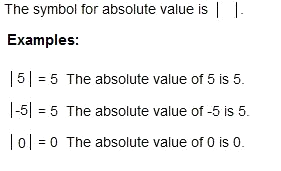The number line represents all the numbers that we use. Remember that
signed numbers include:
- positive numbers
- zero
- negative numbers
If a plus sign is in front of a number, it is a positive number.
+1, +2, +3, and so on.
If a negative sign is in front of a number, it is a negative number.
-1, -2, -3, and so on.
Keep in mind that it is not necessary to place a plus sign in front of positive numbers.
Some Helpful Tools
This section will cover the fundamentals of signed numbers and where they are positioned on the number line.
The Number Line
Absolute value is the distance on the number line between zero and the number.
Since distance is always expressed as positive, the absolute number is always written as positive.
Absolute Value
Greater or Less Than
Symbols are used to show that a number is greater in value than another number.
The greater than symbol is >.
The less than symbol is <.
To tell them apart, you could say that symbol is open towards the greater number.
Notice that the further the numbers go to the left, the lesser the value of the number becomes.
Examples:
5 < 7
9 > 3
4.5 > 2
-2 < 2
-3 < 1
Five is less than seven.
Nine is greater than three.
Four and five tenths is greater than two.
Negative two is less than positive two.
Negative three is less than positive one.
All negative numbers are on the left side of zero on the number line. All positive numbers are on the right side of zero on the number.
Zero is neither positive nor negative.
Numbers can be written as whole numbers, fractions, or decimals.
Math: Number Relationships - Tutorial


